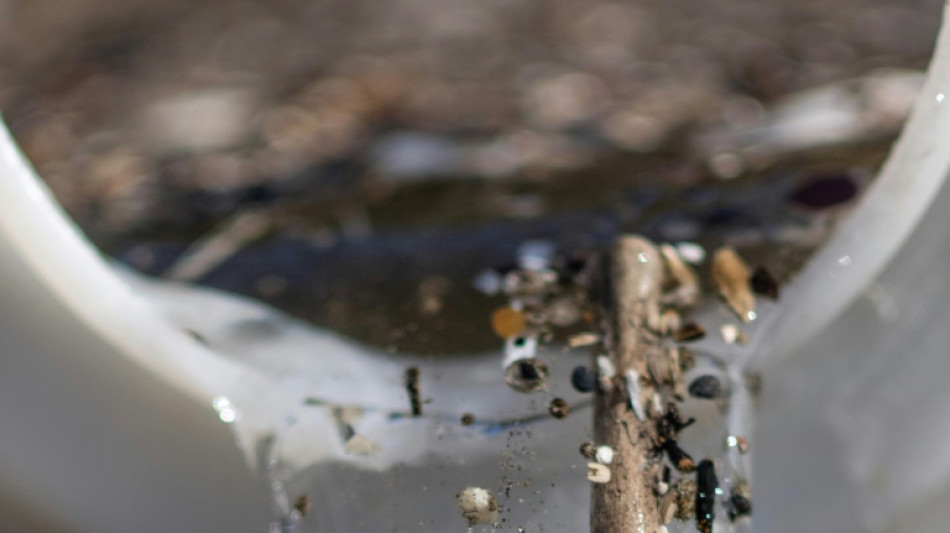
-
 Sampaoli beaten on Rennes debut as angry fans disrupt Nantes loss
Sampaoli beaten on Rennes debut as angry fans disrupt Nantes loss
-
Chiefs edge Panthers, Lions rip Colts as Dallas stuns Washington

-
 Uruguayans vote in tight race for president
Uruguayans vote in tight race for president
-
Thailand's Jeeno wins LPGA Tour Championship

-
 'Crucial week': make-or-break plastic pollution treaty talks begin
'Crucial week': make-or-break plastic pollution treaty talks begin
-
Israel, Hezbollah in heavy exchanges of fire despite EU ceasefire call

-
 Amorim predicts Man Utd pain as he faces up to huge task
Amorim predicts Man Utd pain as he faces up to huge task
-
Basel backs splashing the cash to host Eurovision

-
 Petrol industry embraces plastics while navigating energy shift
Petrol industry embraces plastics while navigating energy shift
-
Italy Davis Cup winner Sinner 'heartbroken' over doping accusations

-
 Romania PM fends off far-right challenge in presidential first round
Romania PM fends off far-right challenge in presidential first round
-
Japan coach Jones abused by 'some clown' on Twickenham return

-
 Springbok Du Toit named World Player of the Year for second time
Springbok Du Toit named World Player of the Year for second time
-
Iran says will hold nuclear talks with France, Germany, UK on Friday

-
 Mbappe on target as Real Madrid cruise to Leganes win
Mbappe on target as Real Madrid cruise to Leganes win
-
Sampaoli beaten on Rennes debut as fans disrupt Nantes loss

-
 Israel records 250 launches from Lebanon as Hezbollah targets Tel Aviv, south
Israel records 250 launches from Lebanon as Hezbollah targets Tel Aviv, south
-
Australia coach Schmidt still positive about Lions after Scotland loss

-
 Man Utd 'confused' and 'afraid' as Ipswich hold Amorim to debut draw
Man Utd 'confused' and 'afraid' as Ipswich hold Amorim to debut draw
-
Sinner completes year to remember as Italy retain Davis Cup

-
 Climate finance's 'new era' shows new political realities
Climate finance's 'new era' shows new political realities
-
Lukaku keeps Napoli top of Serie A with Roma winner

-
 Man Utd held by Ipswich in Amorim's first match in charge
Man Utd held by Ipswich in Amorim's first match in charge
-
'Gladiator II', 'Wicked' battle for N. American box office honors

-
 England thrash Japan 59-14 to snap five-match losing streak
England thrash Japan 59-14 to snap five-match losing streak
-
S.Africa's Breyten Breytenbach, writer and anti-apartheid activist

-
 Concern as climate talks stalls on fossil fuels pledge
Concern as climate talks stalls on fossil fuels pledge
-
Breyten Breytenbach, writer who challenged apartheid, dies at 85

-
 Tuipulotu try helps Scotland end Australia's bid for Grand Slam
Tuipulotu try helps Scotland end Australia's bid for Grand Slam
-
Truce called after 82 killed in Pakistan sectarian clashes

-
 Salah wants Liverpool to pile on misery for Man City after sinking Saints
Salah wants Liverpool to pile on misery for Man City after sinking Saints
-
Berrettini takes Italy to brink of Davis Cup defence

-
 Lille condemn Sampaoli to defeat on Rennes debut
Lille condemn Sampaoli to defeat on Rennes debut
-
Basel backs splashing the bucks to host Eurovision

-
 Leicester sack manager Steve Cooper
Leicester sack manager Steve Cooper
-
IPL auction records tumble as Pant, Iyer break $3 mn mark

-
 Salah sends Liverpool eight points clear after Southampton scare
Salah sends Liverpool eight points clear after Southampton scare
-
Key Trump pick calls for end to escalation in Ukraine

-
 Tuipulotu try helps Scotland end Australia's bid for a Grand Slam
Tuipulotu try helps Scotland end Australia's bid for a Grand Slam
-
Davis Cup organisers hit back at critics of Nadal retirement ceremony

-
 Noel in a 'league of his own' as he wins Gurgl slalom
Noel in a 'league of his own' as he wins Gurgl slalom
-
A dip or deeper decline? Guardiola seeks response to Man City slump

-
 Germany goes nuts for viral pistachio chocolate
Germany goes nuts for viral pistachio chocolate
-
EU urges immediate halt to Israel-Hezbollah war

-
 Far right targets breakthrough in Romania presidential vote
Far right targets breakthrough in Romania presidential vote
-
Basel votes to stump up bucks to host Eurovision

-
 Ukraine shows fragments of new Russian missile after 'Oreshnik' strike
Ukraine shows fragments of new Russian missile after 'Oreshnik' strike
-
IPL auction records tumble as Pant and Iyer snapped up

-
 Six face trial in Paris for blackmailing Paul Pogba
Six face trial in Paris for blackmailing Paul Pogba
-
Olympic champion An wins China crown in style


How harmful are microplastics to human health?
Microplastics have been found throughout the human body -- including inside lungs, blood and brains -- and while it is not yet clear how harmful they are to our health, some researchers are sounding the alarm.
These tiny pieces of plastic have been detected almost everywhere on Earth, from the deepest oceans to the highest mountains, as well as in the air, water, soil and food chain.
Every day humans ingest, inhale or otherwise come in contact with microplastics, which are less than five millimetres (0.2 inches) and mostly invisible to the naked eye.
"A human in 2024 has plastic in almost all the organs of their body," French specialist researcher Fabienne Lagarde recently told a hearing of France's parliament.
"And it will probably be even worse for the children born in 2040," she added.
Numerous studies have linked the presence of microplastics -- or nanoplastics which are 1,000 times smaller -- to a range of health problems.
In March, a study in the New England Journal of Medicine found an association between microplastics accumulating in people's blood vessels and an increased risk of heart attack, stroke or even early death.
- 'Red flag' -
"The body of research on microplastics is growing and it is already showing us that the health impacts are very concerning," said Tracey Woodruff, a researcher at the University of California, San Francisco.
Woodruff recently conducted a systematic review of 2,000 previous studies on animals, finding that microplastics "can harm fertility, are linked to increased cancer risk and can harm respiratory health," she told AFP.
It is a "red flag" that microplastics have been found in so many areas of the body "including the brain, testes and even crossing the placenta into the foetus," she added.
Many of the most worrying studies, such as the one from March, have been observational. This means they cannot prove microplastics are directly causing the health problems they have been linked to.
Others have been conducted in the lab, sometimes testing on animals, which some observers see as a limitation.
For the studies she reviewed, Woodruff said the biological systems of the animals were "quite similar to humans".
She added that "data from animals has been used to identify carcinogens and reproductive toxicants for decades."
Many things remain unknown about how microplastics could affect health, including the role played by their size, shape and composition.
Many plastics are a complex cocktail of polymers and chemicals, and there are fears they could smuggle in other contaminants in what is called the "Trojan Horse" effect.
- Plastic pollution treaty? -
Out of the more than 16,000 chemicals used or found in commercial plastic, more than a quarter are considered hazardous to human health, according to a group called the Scientists' Coalition for an Effective Plastics Treaty.
Linked health concerns include "infertility, obesity and non-communicable diseases including diabetes, cardiovascular disease and many cancers," the group said.
How damaging all this tiny plastic is to health also depends on how much humans are exposed to, which also remains unclear.
A report from the World Wildlife Fund made headlines in 2019 by estimating that people ingest around five grams of plastic a week, the equivalent of a credit card.
The methodology and results of the report have since been called into question, with numerous studies estimating lower levels of ingested plastic -- and showing that rates vary hugely across the world.
It is still early days for the field, with research into how microplastics impact health only beginning in the early 2000s.
"Despite the newness of the topic and the limitations that have been identified, the dangers linked to oral exposure and inhalation are there," Muriel Mercier-Bonin, a researcher at France's INRAE institute, told the French parliament.
And the problem is only growing. Plastic production has doubled in 20 years and at current rates could triple by 2060, according to the OECD.
The United Nations has agreed to work towards a world-first treaty to reduce plastic pollution, with negotiators meeting in a month for a final round of talks.
In the meantime, experts recommend people limit their exposure to microplastics by avoiding plastic bottles, not heating food in plastic containers, wearing clothes made of natural material and ventilating their home.
D.Schneider--BTB


